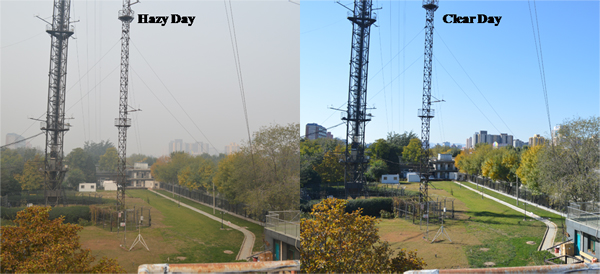Where Are the Organic Aerosols in Summer and Autumn from?
Date:2014-12-23
Fine particles are the primary pollutant for the heavy haze in Beijing, while OA (organic aerosol) accounts for 30%–50% of the total particulate mass of PM1 (particulate matter with an aerodynamic diameter <1 μm). Compare with inorganic species, the impacts of OA on climate, visibility, and human health are more complex. Therefore, a thorough understanding of the OA characteristics, sources, and the processes it undergoes in the atmosphere are very important for addressing aerosol-related pollution issues, and for the improvement of the predictive capability of air quality and climate models.

(Photo of 325 m meteorological tower of IAP taken in October 2013 in Beijing. Credit: Dr. ZHANG Junke)
A high-resolution time-of-flight aerosol mass spectrometer (HR-ToF-AMS, Aerodyne Research Inc., USA) was used by scientists from State Key Laboratory of Atmospheric Boundary Layer Physics and Atmospheric Chemistry (LAPC), Institute of Atmospheric Physics in August and October 2012 respectively to achieve an in-depth understanding of OA in summer and autumn and to analyze OA chemical characteristics, processes and sources. It is found that: (1) The mean OA mass concentration in autumn was 30±30 μg m-3, which was higher than in summer (13±6.9 μg m-3). The elemental analysis found that OA was more aged in summer; (2) Positive matrix factorization (PMF) analysis found that the OA always dominated by secondary OA (SOA) in two seasons. A clear and unique diurnal pattern of COA was observed, with two peaks at noon and in the evening, corresponding to the lunch and evening meal times of the local residents. In addition, it was interesting to find a small peak corresponding to breakfast time on autumn mornings. However, it did not appear in summer. Perhaps residents choose not to cook breakfast in the summer due to the hot weather; (3) Back trajectory clustering analysis found that the origin of the air masses was more complex in summer. Southerly air masses in both seasons were associated with the highest OA loading, and was rich in secondary organic aerosol (SOA). While northerly air masses were associated with the lowest OA loading, and contained a large fraction of primary organic aerosol (POA); (4) There was a significant effect of human activities on the OA components, especially during the long National Day holiday, when the POA levels obviously decreased.
Slideshow Summary
This research was recently accepted by Advances in Atmospheric Sciences.
Download: http://159.226.119.58/aas/EN/abstract/abstract2614.shtml
Key words: organic aerosol, aerosol mass spectrometer, positive matrix factorization, seasonal difference
Contact: Dr. ZHANG Junke (zhangjunke@dq.cern.ac.cn)
